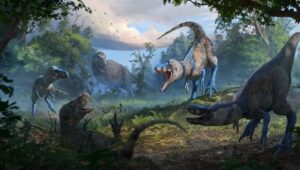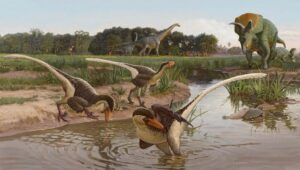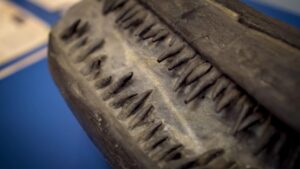A fossil enthusiast has discovered a huge pliosaur skull in the cliffs of Dorset, England. Phil Jacobs first spotted the top of the snout in shingle on the beach at Kimmeridge Bay last year. The incredible sea monster skull is two meters long and contains 130 razor-sharp teeth.
After spotting the fossil, Jacobs sought out his friend and fossil expert, Steve Etches. Etches has been making discoveries for 30 years on this so-called Jurassic Coast, a goldmine for dinosaur fossils. The pair made a makeshift stretcher to carry the heavy bone fragment away for analysis.

The excavation site. Photo: BBC Studios
Drone pinpoints the location
If part of the snout was on the beach, Etches was sure that the rest of the skull must be relatively close by. Using drones, they found it buried in the side of the cliff.
Then came the hard part: extracting the skull. Extracting a fossil can be painstakingly slow and difficult at the best of times. When the skull is embedded in a crumbling cliff 15m up, it is even harder. A team had to rappel and extract the fossil on ropes.
The spectacular find has attracted scientists from around the world and it will be the subject of an upcoming David Attenborough documentary. It is incredibly rare to find a 150 million-year-old specimen in such good condition.
“The lower jaw and the upper skull are meshed together, as they would be in life. Worldwide, there are hardly any specimens [with] that level of detail. And if there are, a lot of the bits are missing, whereas this, although it’s slightly distorted, it’s got every bone present,” Etches told the BBC.
More ferocious than T-Rex
The pliosaur was the ocean’s apex predator during the Jurassic period. Reaching up to 12m long, its jaw could exert a force of 33,000 newtons. For context, the jaw of a saltwater crocodile can exert 16,000 newtons. There’s nothing comparable to it today.

David Attenborough and Steve Etches look at the snout. Photo: BBC Studios
“It’s a big carnivorous reptile and one of the largest that ever lived in the sea. It’s even larger and more ferocious than a T-Rex,” Etches said.
The pliosaur would have hunted dolphin-like creatures.
But where is the rest of the fossil? Etches is positive it is within the cliff. As it erodes, the body will likely emerge.






